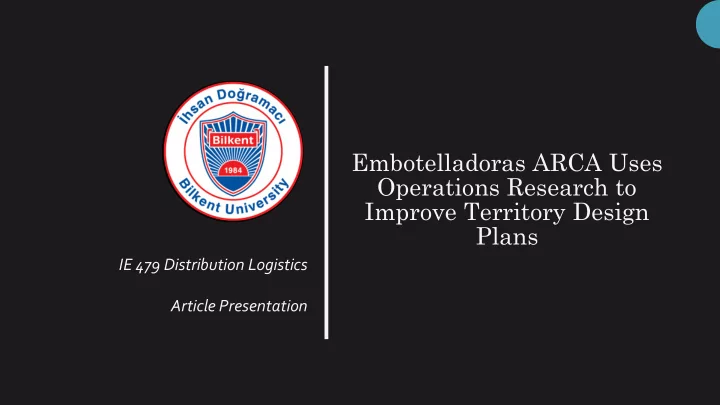

Embotelladoras ARCA Uses Operations Research to Improve Territory Design Plans IE 479 Distribution Logistics Article Presentation
• J. Fabián López - Pérez, Roger Z. Ríos - Mercado, (2013) Embotelladoras ARCA Uses Operations Research to Improve Territory Design Plans. INFORMS Journal on Applied Analytics 43(3): 209-220. Chosen Article 2
Embotelladoras ARCA The second-largest bottler of Coca-Cola products – in Latin America. Introduction – Dedicated to the production, distribution, and sales of soft drink brands owned by the Coca-Cola Company, ARCA, and third parties. – The company has soft drink sales of more than 1.2 billion unit cases. 3
The market’s large size leads to several problems. • Imbalanced product demand and number of customers among the territories. • Balancing the number of customers a fair work Problem distribution among the salespersons who handle the individual orders. Definition • Balancing product demand a fair distribution among the truck drivers. • How to segment or partition customers into clusters or territories (Territory Design Problem). Problem of grouping basic units (i.e., city blocks, zip codes, or individual customers), which we call BUs, into 4 territories according to specific planning criteria.
● Deterministic product demand. Assumptions ● A fixed set of territory centers (focusing on the allocation phase of the process) ● 50 territories, 5000 BUs 5
1. Compactness: customers are as close to each other as possible 2. Balance: with respect to number of customers and product demand 3. Territory connectivity: a truck assigned to a territory can Planning Criteria deliver goods without leaving the territory 4. Disjoint BU assignment: avoids assigning two given BUs to the same territory 5. Similarity to an existing plan for a subset of BUs. Given a set of city blocks or BUs, it is desired to create a specific number of territories according to the planning 6 criteria:
Method • Solve the AMR (allocation model relaxation) and check if the solutions obtained satisfy the connectivity constraints. The figure shows the steps in the • To determine the violated connectivity constraints, solve pseudocode of the solution procedure. . a relatively easy separation problem and add these cuts to the AMR. • This procedure iterates until no additional connectivity 7 constraints are found; therefore, an optimal solution to the AM is obtained.
Method The figure shows the decision variables and parameters for the Allocation Model . 8
Method The figure shows the Allocation Model . 9
Results A comparison between old and new design in terms of number of customers (top) and product demand (bottom). The charts plot the distribution of the corresponding activity measure for each of the 50 territories. The tolerance 10 limits are depicted as dotted lines..
Results This figure displays the previous territory plan used by Embotelladoras ARCA in Monterrey. Territory 1 had 95 BUs, territory 44 had 128 BUs. 11 Territory 14 had 68 BUs, territory 33 had 100 BUs.
Results This figure shows the new territory plan in Monterrey (tolerance = 5 %) after the solution of the developed model.. 12 Territory 1 now has 100 BUs, territory 44 has 106 BUs. Territory 14 has 88 BUs, territory 33 has 90 BUs.
Results This figure plots the trade-off between the balance constraint tolerance parameter and the dispersion measure value 13
• Reducing the many territory imbalances -Achieved by incorporating the balancing constraints into the model and defining an appropriate value for the tolerance parameter Implementation • Issue of realignment Challenges -Many customers have established long-term relationships with the team (salespersons and truck drivers) -Achieved by incorporating a penalty term into the objective to penalize for differences from the existing Several technical issues arose during the plan implementation of the new designs: 14
• Identification of a rational set of activity measures to target and balance each truck resource • Manual planning process time was reduced from Benefits 2 weeks to less than 1 hour using the new OR application • 15 % reduction from the original number of delivery routes • Streamlined truck capacity aligned to a new end customer distribution strategy (8% savings of the entire fleet) 15
• Identification and implementation of an optimal cost of service, depending on each route model type optimal frequency for customer delivery Benefits operations with less travel time • Improved territory compactness and elimination of territory overlapping • The model will allow the company to speed up some other route-to-market initiatives of special interest among Coca-Cola bottlers worldwide 16
• Implemented on a natural gas distribution company • Main purpose: Performing field operations in time with Comparison minimum number of mobile teams • in Turkey District Design Problem District Design And Route Planning For Customer-Related Field Operations Of Natural Gas Distribution Systems: A Case Study • Mobile teams are assigned to districts to planning services using the mathematical model of Multiple 17 Travelling Salesman Problem
Comparison ● Territorial Design for Matching Green Energy Supply and Energy Consumption: The Case of in Turkey Turkey ● Case — Assigning Regions to Sales Representatives at Pfizer Turkey 18
• GRASP with path relinking for commercial districting ○ If the centers are “badly” located, the resulting design may cause a serious Additional deterioration in objective function ○ Center-based dispersion functions have the References disadvantage of being very costly within heuristic search ○ Non-center based dispersion function ○ Longest distance between any two basic units in a territory ○ Heuristic rather than mixed integer programming model ○ Greedy Randomized Adaptive Search Procedure (GRASP) 19
Thank you for listening Çağla Aközlü 21502864 Muzaffer Eralp Çalhan 21502683 Akif Fırat Ertaş 20802486 Ebru Tarhan 21501244 20
Recommend
More recommend